
The Devonian is a geologic period and system of the Paleozoic era during the Phanerozoic eon, spanning 60.3 million years from the end of the preceding Silurian period at 419.2 million years ago (Ma), to the beginning of the succeeding Carboniferous period at 358.9 Ma. It is named after Devon, South West England, where rocks from this period were first studied.

A tetrapod is any four-limbed vertebrate animal of the superclass Tetrapoda. Tetrapods include all extant and extinct amphibians and amniotes, with the latter in turn evolving into two major clades, the sauropsids and synapsids. Some tetrapods such as snakes, legless lizards, and caecilians had evolved to become limbless via mutations of the Hox gene, although some do still have a pair of vestigial spurs that are remnants of the hindlimbs.
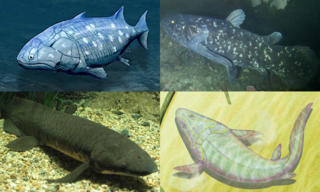
Sarcopterygii — sometimes considered synonymous with Crossopterygii — is a taxon of the bony fish known as the lobe-finned fish or sarcopterygians, characterised by prominent muscular limb buds (lobes) within the fins, which are supported by articulated appendicular skeletons. This is in contrast to the other clade of bony fish, the Actinopterygii, which have only skin-covered bony spines (lepidotrichia) supporting the fins.

Ichthyostega is an extinct genus of limbed tetrapodomorphs from the Late Devonian of what is now Greenland. It was among the earliest four-limbed vertebrates ever in the fossil record and was one of the first with weight-bearing adaptations for terrestrial locomotion. Ichthyostega possessed lungs and limbs that helped it navigate through shallow water in swamps. Although Ichthyostega is often labelled a 'tetrapod' because of its limbs and fingers, it evolved long before true crown group tetrapods and could more accurately be referred to as a stegocephalian or stem tetrapod. Likewise, while undoubtedly of amphibian build and habit, it is not a true member of the group in the narrow sense, as the first modern amphibians appeared in the Triassic Period. Until finds of other early stegocephalians and closely related fishes in the late 20th century, Ichthyostega stood alone as a transitional fossil between fish and tetrapods, combining fish and tetrapod features. Newer research has shown that it had an unusual anatomy, functioning more akin to a seal than a salamander, as previously assumed.

Eusthenopteron is a genus of prehistoric sarcopterygian which has attained an iconic status from its close relationships to tetrapods. Early depictions of this animal show it emerging onto land; however, paleontologists now widely agree that it was a strictly aquatic animal. The genus Eusthenopteron is known from several species that lived during the Late Devonian period, about 385 million years ago. Eusthenopteron was first described by J. F. Whiteaves in 1881, as part of a large collection of fishes from Miguasha, Quebec. Some 2,000 Eusthenopteron specimens have been collected from Miguasha, one of which was the object of intensely detailed study and several papers from the 1940s to the 1990s by paleoichthyologist Erik Jarvik.

The Tetrapodomorpha are a clade of vertebrates consisting of tetrapods and their closest sarcopterygian relatives that are more closely related to living tetrapods than to living lungfish. Advanced forms transitional between fish and the early labyrinthodonts, such as Tiktaalik, have been referred to as "fishapods" by their discoverers, being half-fish, half-tetrapods, in appearance and limb morphology. The Tetrapodomorpha contains the crown group tetrapods and several groups of early stem tetrapods, which includes several groups of related lobe-finned fishes, collectively known as the osteolepiforms. The Tetrapodomorpha minus the crown group Tetrapoda are the stem Tetrapoda, a paraphyletic unit encompassing the fish to tetrapod transition.
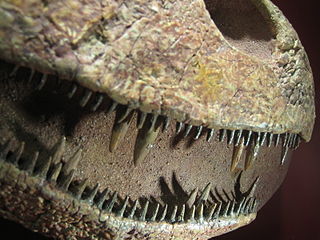
Tristichopterids (Tristichopteridae) were a diverse and successful group of tetrapodomorph fishes living throughout the Middle and Late Devonian. They first appeared in the Eifelian stage of the Middle Devonian. Within the group sizes ranged from a few tens of centimeters (Tristichopterus) to several meters.
Kenichthys is a genus of sarcopterygian fish from the Devonian period, and a member of the clade Tetrapodomorpha. The only known species of the genus is Kenichthys campbelli, the first remains of which were found in China in 1993. The genus is important to the study of the evolution of tetrapods due to the unique nature of its nostrils, which provide vital evidence regarding the evolutionary transition of fish-like nostrils to the tetrapod choanae.
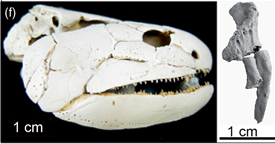
Gogonasus was a lobe-finned fish known from three-dimensionally preserved 380-million-year-old fossils found from the Gogo Formation in Western Australia. It lived in the Late Devonian period, on what was once a 1,400-kilometre coral reef off the Kimberley coast surrounding the north-west of Australia. Gogonasus was a small fish reaching 30–40 cm (1 ft) in length.
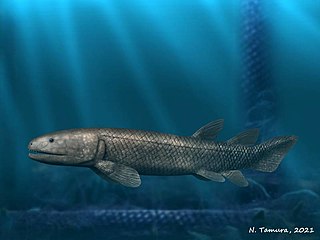
Megalichthyiformes is an extinct clade of basal tetrapodomorphs which first appeared during the Devonian period. It was named in 2010 by Michael I. Coates and Matt Friedman, who defined it as a stem-based taxon containing all tetrapodomorphs closer to Megalichthys than to Eusthenopteron.

Rhizodus is an extinct genus of basal, finned tetrapodomorphs. It belonged to Rhizodontida, one of the earliest-diverging tetrapodomorph clades. Two valid species have been described, both of which lived during the Early Carboniferous epoch. The type species R. hibberti is known from the Viséan stage of the United Kingdom, whereas the species R. serpukhovensis is from the Serpukhovian of Russia. Some fossils referred to the genus Rhizodus have also been found in North America.

Elpistostege is an extinct genus of finned tetrapodomorphs that lived during the Frasnian age of the Late Devonian epoch. Its only known species, E. watsoni, was first described in 1938 by the British palaeontologist Thomas Stanley Westoll, based on a single partial skull roof discovered at the Escuminac Formation in Quebec, Canada.

Osteolepiformes, also known as Osteolepidida, is a group of prehistoric lobe-finned fishes which first appeared during the Devonian period. The order contains the families Canowindridae, Megalichthyidae, Osteolepididae and Tristichopteridae. The order is generally considered to be paraphyletic because the characters that define it are mainly attributes of stem tetrapodomorphs.
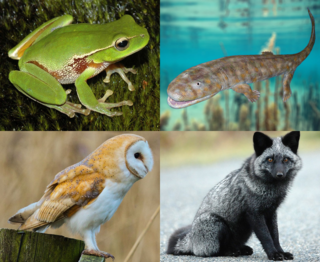
Stegocephali is a clade of vertebrate animals containing all fully limbed tetrapodomorphs. It is equivalent to a broad definition of the superclass Tetrapoda: under this broad definition, the term "tetrapod" applies to any animal descended from the first vertebrate with four limbs each with five digits in the extremity (pentadactyly), rather than fins of their sarcopterygian relatives.
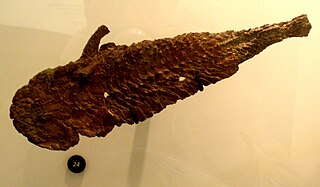
Megalichthyidae is an extinct family of tetrapodomorphs which lived from the Middle–Late Devonian to the Early Permian. They are known primarily from freshwater deposits, mostly in the Northern Hemisphere, but one genus (Cladarosymblema) is known from Australia, and the possible megalichthyid Mahalalepis is from Antarctica.

Osteolepididae is a family of primitive, fish-like tetrapodomorphs that lived during the Devonian period. The family is generally thought to be paraphyletic, with the traits that characterise the family being widely distributed among basal tetrapodomorphs and other osteichthyans. Some of genera historically placed in Osteolepididae have more recently been assigned to the family Megalichthyidae, which appears to be a monophyletic group.
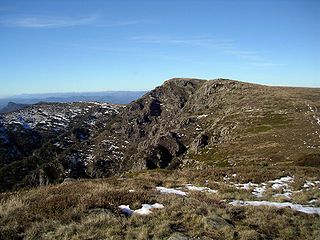
Marsdenichthys is an extinct genus of Devonian tetrapodomorph. Fossils have been found from Mount Howitt in Victoria, Australia from strata that are Givetian-Frasnian in age. Mount Howitt is an important site that has been the source of many tetrapodomorph fossils, including Beelarongia and Howittichthys, both of which were first described from the locality.

Eotetrapodiformes is a clade of tetrapodomorphs including the four-limbed vertebrates and their closest finned relatives, two groups of stem tetrapods called tristichopterids and elpistostegalids.

The evolution of fish began about 530 million years ago during the Cambrian explosion. It was during this time that the early chordates developed the skull and the vertebral column, leading to the first craniates and vertebrates. The first fish lineages belong to the Agnatha, or jawless fish. Early examples include Haikouichthys. During the late Cambrian, eel-like jawless fish called the conodonts, and small mostly armoured fish known as ostracoderms, first appeared. Most jawless fish are now extinct; but the extant lampreys may approximate ancient pre-jawed fish. Lampreys belong to the Cyclostomata, which includes the extant hagfish, and this group may have split early on from other agnathans.

Elginerpetontidae is an extinct family of basal stegocephalian tetrapodomorphs which lived in Europe during the Frasnian stage of the Late Devonian epoch. It contains the genera Elginerpeton, Obruchevichthys and Webererpeton.
























